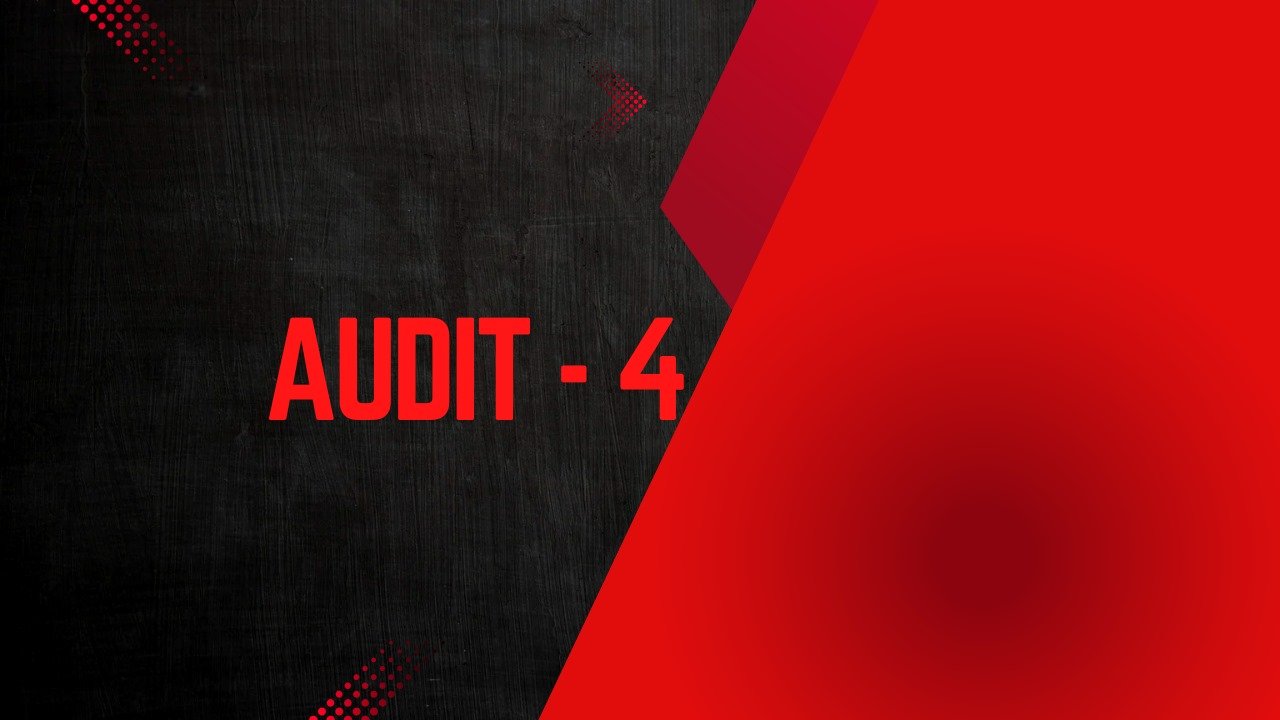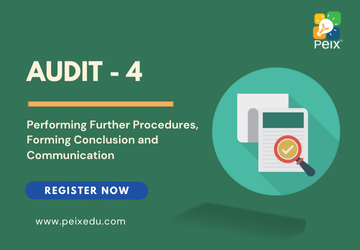About this course
This module of the CPA Audit course focuses on the critical final stages of the audit process. It covers the procedures auditors perform when additional evidence is needed, how to evaluate audit findings, and how to form conclusions based on the evidence gathered. Students will learn about substantive procedures, tests of controls, and other necessary audit steps to ensure the financial statements are free from material misstatement.
The course also delves into the importance of professional judgment in forming audit conclusions and the various factors that impact these decisions. Learners will explore the process of communicating audit results, including the preparation of the final audit report, management letters, and any required disclosures. By examining real-world case studies and applying key auditing standards, students will develop the skills necessary to effectively perform further procedures, assess the audit evidence, and communicate findings to stakeholders.
Comments (0)
This section of the CPA Audit course covers the Revenue Cycle, one of the most critical areas in auditing. Learners will explore the processes involved in revenue recognition, from the initial sale of goods or services to the collection of cash. The course examines key components of the revenue cycle, such as order processing, credit approval, shipping, invoicing, and cash receipts.
Students will also learn to identify risks associated with the revenue cycle, including issues related to fraud, overstatement, and improper recognition of revenue. The course will cover the auditor's responsibility in evaluating internal controls within the revenue cycle, performing substantive testing, and assessing the appropriateness of revenue recognition policies in accordance with applicable accounting standards like GAAP or IFRS.
Through practical examples and case studies, students will gain hands-on experience in auditing the revenue cycle, ensuring financial statements are accurate and in compliance with regulatory standards.
This section of the CPA Audit course covers the Revenue Cycle, one of the most critical areas in auditing. Learners will explore the processes involved in revenue recognition, from the initial sale of goods or services to the collection of cash. The course examines key components of the revenue cycle, such as order processing, credit approval, shipping, invoicing, and cash receipts.
Students will also learn to identify risks associated with the revenue cycle, including issues related to fraud, overstatement, and improper recognition of revenue. The course will cover the auditor's responsibility in evaluating internal controls within the revenue cycle, performing substantive testing, and assessing the appropriateness of revenue recognition policies in accordance with applicable accounting standards like GAAP or IFRS.
Through practical examples and case studies, students will gain hands-on experience in auditing the revenue cycle, ensuring financial statements are accurate and in compliance with regulatory standards.
This section of the CPA Audit course covers the Revenue Cycle, one of the most critical areas in auditing. Learners will explore the processes involved in revenue recognition, from the initial sale of goods or services to the collection of cash. The course examines key components of the revenue cycle, such as order processing, credit approval, shipping, invoicing, and cash receipts.
Students will also learn to identify risks associated with the revenue cycle, including issues related to fraud, overstatement, and improper recognition of revenue. The course will cover the auditor's responsibility in evaluating internal controls within the revenue cycle, performing substantive testing, and assessing the appropriateness of revenue recognition policies in accordance with applicable accounting standards like GAAP or IFRS.
Through practical examples and case studies, students will gain hands-on experience in auditing the revenue cycle, ensuring financial statements are accurate and in compliance with regulatory standards.
This section of the CPA Audit course focuses on the Expenditure Cycle, which encompasses the process of acquiring goods and services and the subsequent payments made to vendors. Learners will explore the key stages of the expenditure cycle, including purchasing, receiving, invoice processing, and payment. The course will also cover the various risks associated with the cycle, such as unauthorized purchases, improper recording of liabilities, and overstatement of expenses.
Students will gain insight into the auditor's role in assessing internal controls within the expenditure cycle, evaluating vendor transactions, and performing substantive procedures to ensure expenses are properly recorded and liabilities are accurately stated. Additionally, the course will address compliance with accounting standards and how auditors verify the accuracy and completeness of financial reporting in relation to the expenditure cycle.
This section of the CPA Audit course focuses on the Expenditure Cycle, which encompasses the process of acquiring goods and services and the subsequent payments made to vendors. Learners will explore the key stages of the expenditure cycle, including purchasing, receiving, invoice processing, and payment. The course will also cover the various risks associated with the cycle, such as unauthorized purchases, improper recording of liabilities, and overstatement of expenses.
Students will gain insight into the auditor's role in assessing internal controls within the expenditure cycle, evaluating vendor transactions, and performing substantive procedures to ensure expenses are properly recorded and liabilities are accurately stated. Additionally, the course will address compliance with accounting standards and how auditors verify the accuracy and completeness of financial reporting in relation to the expenditure cycle.
This section of the CPA Audit course focuses on the Cash Cycle, a crucial area of the audit that addresses the flow of cash within an organization, from the receipt of cash to its disbursement. Learners will explore the processes involved in cash collections, disbursements, and management, as well as the controls in place to safeguard cash. The course will examine how auditors assess the effectiveness of internal controls over cash handling, identify potential risks such as misappropriation of funds or fraud, and ensure cash transactions are properly recorded.
Students will also learn how to conduct substantive testing on cash balances, evaluate cash flow statements, and verify the accuracy of cash-related disclosures in financial statements. The course will emphasize the importance of auditing the cash cycle to ensure that cash transactions are transparent, appropriately authorized, and in compliance with accounting standards and regulatory requirements.
Through practical examples and case studies, students will gain the skills necessary to effectively audit the cash cycle, ensuring financial statements accurately reflect an organization’s cash position.
This section of the CPA Audit course focuses on the Inventory Cycle, a critical area for auditors due to the potential risks associated with inventory misstatements, including overstatement, fraud, and errors in valuation. Learners will explore the key stages of the inventory cycle, including inventory procurement, storage, movement, and the recognition of inventory in financial statements.
The course will address how auditors assess and test internal controls over inventory management, including inventory counts, pricing methods (e.g., FIFO, LIFO, weighted average), and inventory valuation techniques. Students will learn how to identify risks related to inventory, perform substantive testing to verify quantities and valuations, and ensure proper cut-off procedures to prevent manipulation at year-end.
This section of the CPA Audit course focuses on the Inventory Cycle, a critical area for auditors due to the potential risks associated with inventory misstatements, including overstatement, fraud, and errors in valuation. Learners will explore the key stages of the inventory cycle, including inventory procurement, storage, movement, and the recognition of inventory in financial statements.
The course will address how auditors assess and test internal controls over inventory management, including inventory counts, pricing methods (e.g., FIFO, LIFO, weighted average), and inventory valuation techniques. Students will learn how to identify risks related to inventory, perform substantive testing to verify quantities and valuations, and ensure proper cut-off procedures to prevent manipulation at year-end.
This section of the CPA Audit course focuses on the Investment Cycle, which involves the acquisition, management, and disposal of investments held by an organization. Learners will explore the processes related to investments in financial instruments such as stocks, bonds, and other securities. The course will cover key elements of the investment cycle, including purchasing, valuation, income recognition, and the sale or maturity of investments.
Students will gain insight into how auditors evaluate the effectiveness of internal controls surrounding investment activities, ensure compliance with accounting standards (such as the fair value and classification requirements of GAAP or IFRS), and assess risks related to misstatement or fraud in investment transactions. The course will also address the auditor’s role in reviewing the classification and valuation of investments, as well as the accuracy of related disclosures in financial statements.
This section of the CPA Audit course focuses on the Investment Cycle, which involves the acquisition, management, and disposal of investments held by an organization. Learners will explore the processes related to investments in financial instruments such as stocks, bonds, and other securities. The course will cover key elements of the investment cycle, including purchasing, valuation, income recognition, and the sale or maturity of investments.
Students will gain insight into how auditors evaluate the effectiveness of internal controls surrounding investment activities, ensure compliance with accounting standards (such as the fair value and classification requirements of GAAP or IFRS), and assess risks related to misstatement or fraud in investment transactions. The course will also address the auditor’s role in reviewing the classification and valuation of investments, as well as the accuracy of related disclosures in financial statements.
This section of the CPA Audit course focuses on the Other Transaction Cycle, which includes all financial transactions not directly related to the core operational cycles (e.g., revenue, expenditure, inventory, and investment cycles). Learners will explore various types of transactions, such as financing activities, related-party transactions, non-operating income, and extraordinary items that can impact financial statements.
The course will cover the auditor's responsibility in reviewing these transactions for accuracy, completeness, and proper classification. Students will learn how to assess risks, such as improper disclosure, misclassification of transactions, or non-compliance with accounting standards. The course will also discuss how to apply auditing procedures to ensure these transactions are accurately recorded and disclosed in the financial statements, following GAAP, IFRS, or other relevant frameworks.
This section of the CPA Audit course focuses on the Other Transaction Cycle, which includes all financial transactions not directly related to the core operational cycles (e.g., revenue, expenditure, inventory, and investment cycles). Learners will explore various types of transactions, such as financing activities, related-party transactions, non-operating income, and extraordinary items that can impact financial statements.
The course will cover the auditor's responsibility in reviewing these transactions for accuracy, completeness, and proper classification. Students will learn how to assess risks, such as improper disclosure, misclassification of transactions, or non-compliance with accounting standards. The course will also discuss how to apply auditing procedures to ensure these transactions are accurately recorded and disclosed in the financial statements, following GAAP, IFRS, or other relevant frameworks.
This section of the CPA Audit course focuses on Written Representations, which are formal statements obtained from management during the audit process. Learners will explore the purpose of written representations, which serve as a key form of audit evidence, confirming management’s assertions about the financial statements, internal controls, and other critical matters.
The course will cover the types of representations auditors typically request, including those related to the accuracy of financial records, compliance with laws and regulations, and the completeness of information provided to auditors. Students will also learn about the auditor’s responsibility in evaluating the reliability of written representations and the circumstances under which the auditor may need to request additional representations or perform further procedures.







